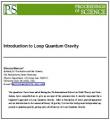
New Paths Towards Quantum Gravity
by B. Booss-Bavnbek, G. Esposito, M. Lesch
Publisher: Springer 2010
ISBN/ASIN: 3642118968
ISBN-13: 9783642118968
Number of pages: 380
Description:
The division of the book in two parts reflects the duality between the physical vision and the mathematical construction. The former is represented by tutorial reviews on non-commutative geometry, on space-time discretization and renormalization and on gauge field path integrals. The latter one by lectures on cohomology, on stochastic geometry and on mathematical tools for the effective action in quantum gravity.
Download or read it online for free here:
Download link
(13MB, PDF)
Similar books
 Spin Foam Models for Quantum Gravity
Spin Foam Models for Quantum Gravityby Alejandro Perez - arXiv
In this article we review the present status of the spin foam formulation of non-perturbative quantum gravity. In the first part we present a general introduction to the main ideas emphasizing their motivations from various perspectives.
(8676 views)
 Generally Covariant Quantum Theory
Generally Covariant Quantum Theoryby Johan Noldus - viXra
The intention of this book is to dig deep in the first principles of physics and develop a relativistic quantum theory from scratch. By this, I mean a theory for the so-called elementary particles which constitute building blocks of nature ...
(5932 views)
 Introduction to Loop Quantum Gravity
Introduction to Loop Quantum Gravityby Simone Mercuri - arXiv
After a description of some general arguments and an introduction to the canonical theory of gravity, the author reviews the background independent approach to quantum gravity, giving only a brief survey of Loop Quantum Gravity.
(9472 views)
 An Elementary Introduction to Loop Quantum Gravity
An Elementary Introduction to Loop Quantum Gravityby Norbert Bodendorfer - arXiv
An introduction to loop quantum gravity is given, focussing on the fundamental aspects of the theory, different approaches to the dynamics, as well as possible future directions. It is structured in five lectures, including exercises.
(6523 views)